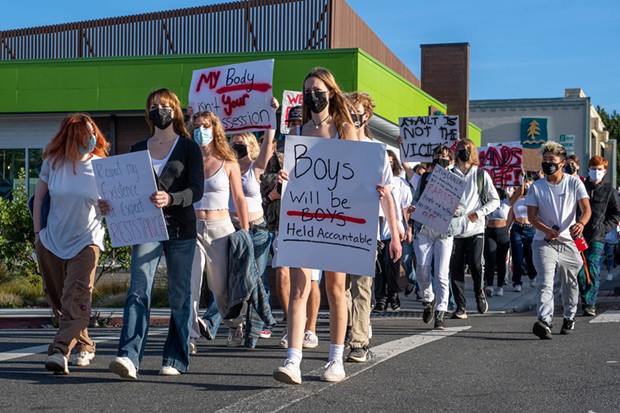By Ginger Jentzen
Thousands of students from dozens of high schools across the country have staged walkouts against sexual assault and harassment since returning to in-person classes. According to data from the U.S. Department of Education’s Office for Civil Rights, reported incidents of sexual violence went up 55% from 2015 – 2018. The increase in reporting marks a clear victory for the #MeToo moment in raising survivors’ confidence to come forward with allegations of abuse. At this phase of the struggle, students are demanding expanded consent-based sex education, accountability from their school administration and the accused, training for school officials, and support for survivors, including counseling.
In St. Paul, MN, students from Highland Park High School walked out saying the school district fosters a “sexual assault culture” because the administration has been slow to discipline a teacher whom students accuse of sexualizing and harassing young women. In solidarity, hundreds of students from three Minneapolis high schools staged their own walkouts. School security pepper sprayed students in Little Elm, Texas when their demonstration escalated; in response, parents backed the frustrated students, who organized another protest against the school security’s violence. Students at several high schools in the Bay Area walked out, including schools where 2019 walkouts inspired a critically acclaimed student film about the #MeToo movement. At a Bellevue, WA high school, the administration expelled the assault survivor and the protest leaders, which only sparked calls for more solidarity demonstrations at more schools!
Expand the struggle to strengthen the fight
One overarching demand of the movement is to strengthen Title IX, a federal law that guarantees students the right to an education without being sexually harassed or assaulted. If the abuse happens on campus or at a school event, the school is required to take legal action. The accused also has the right to due process. Trump’s Education Secretary Betsy DeVos played a key role in weakening Title IX, with the goal of making reporting more challenging and raising the threshold of proof of assault. Despite campaign promises, the Biden administration has so far done nothing to undo the damage done by Trump and Devos.
Beyond Title IX, attacks on public education and educators have put enormous strain on the whole system. The school district of St. Paul, MN appears to have only one Title IX coordinator to serve more than 35,000 students. A recent article in the Guardian quotes the survivors’ rights group Know Your IX’s statistic that almost 40% of students who report their experiences of sexual violence to campus authorities are pushed out of school – forced to drop out, transfer, or take a leave of absence in the wake of reporting.
By the sheer number of demonstrations state by state, it’s clear these walkouts are bolstered by the #MeToo era and students’ raised expectations since returning to in-person learning. Young people’s intolerance of sexual violence, or “careless misogyny” as one student described it, is butting up against school districts being ill-equipped to root out abuse. Where school officials behave more like corporate Human Resources departments than as mandated reporters, students resort to launching anonymous Instagram accounts to make reports. In her Guardian article, Moira Donegan draws comparison between the anonymous Instagrams and a bathroom stall at Brown University in 1990 where students began documenting cases of rape and lambasting their university’s incompetence in handling sexual assault cases.
To strike a blow against the entrenched nature of sexism and sexual violence under capitalism, we must build a united, multiracial, and multigenerational struggle. The furious demonstrations of thousands on college campuses against sexual assault at fraternities this fall won swift concessions from the universities. These concessions cut across the movement developing further in that moment, but students continued discussing how to address deeper, systemic issues of sexism. Winning robust consent-based education, a stronger Title IX, and clear routes for reporting abuse would be significant victories for high school students and an education in the power of direct action with clear demands. However, each district – already consumed by penny-pinching – will only offer the bare minimum concessions to get kids back to class. The student fightback needs to urgently broaden the scope of its demands in order to develop into a formidable force that can win real gains. This needs to include demands for fully funded public schools and mass hiring of educators and support staff. On top of this, these students should take up the fight to defend abortion rights which is certain to be a centerpiece issue this coming spring.












